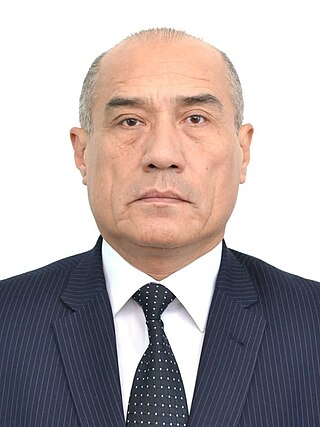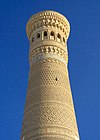
Tashkent or Toshkent ; historically known as Chach, Shash, Binkat) is the capital and largest city of Uzbekistan. It is the most populous city in Central Asia, with a population of 3 million. It is located in northeastern Uzbekistan, near the border with Kazakhstan.

'Ali-Shir Nava'i, also known as Nizām-al-Din ʿAli-Shir Herawī was a Timurid poet, writer, statesman, linguist, Hanafi Maturidi mystic and painter who was the greatest representative of Chagatai literature.
Chingiz Akhmarov was an Uzbek muralist, portraitist, miniature painter and teacher. In 1964, he was conferred the title People's Artist of Uzbekistan. He is held in high regard in Uzbekistan and is credited as one of the artists who kept the tradition of Uzbek miniatures alive.

Alisher Mirzo is an Uzbek painter whose works are kept in galleries, museums and private collections in Germany, France, Italy, Spain, Norway, Luxembourg, Bulgaria, Yugoslavia, Russia, Japan, India, Madagascar and the United States of America. He combines elements of Impressionism and Abstract Art with traditional Uzbek art forms such as miniature painting and decorative styles of applied art. His subjects range from landscapes and still lives to intimate scenes of ethnic Uzbek life.

The Navoi Theater is the national opera theater in Tashkent, Uzbekistan.

Tashkent State Technical University (TSTU) is one of the oldest universities in Uzbekistan. Currently, the university consists of 6 faculties, and prepares highly skilled professionals in technical and engineering fields. For this year, it is estimated to run 56 departments with over 10 746 students, who are taught by 6 academicians of the Academy of Sciences of Uzbekistan, 74 doctors of sciences and 314 candidates of sciences.
The Tashkent Automobile and Road Construction Institute was established in Tashkent, Uzbekistan to meet the high demands for professionals in the transportation and automobile fields.
The Museum of Communication History in Uzbekistan, is a unique and the first museum in the history of Uzbekistan which is related to the communication technologies. It was established in 2009, and nowadays the museum became one of the most famous museums among Uzbek people.

Museum of Victims of Political Repression in Tashkent — is a museum which tells the history of Uzbekistan during the political repression in the Soviet Union, in particular that of the people killed at that time. The Museum is divided into 10 parts.

The Museum of Geology in Tashkent, Uzbekistan is a geology museum that shows and represents the wealth of mineral and geological resources in Uzbekistan, including valuable stones, minerals and archaeological and paleontological findings.
The Uzbekistan State Museum of Nature is the oldest museum operating in Uzbekistan. The museum's main purpose is to show the natural beauty of Uzbekistan and to help protect its environment. The museum features chronologically-ordered exhibits and seeks to educate visitors about Uzbekistan's geography through time.
Art Gallery of Uzbekistan is established in Tashkent city, after the Independence of Republic Uzbekistan, and became one of the most visited modern museums of local people in Uzbekistan.
The Tashkent Polytechnical Museum is an automotive museum in Tashkent, Uzbekistan. The museum provides technical and mechanical information about cars made from 1800 to 1900, focusing on the history of automobile technology and production in Uzbekistan and around the world. It is located in the Mirabad district of Tashkent.
The Museum of Health Care of Uzbekistan is in Uzbekistan. It was established in order to contribute information about the medicine and hygiene among the Uzbek people in an interesting way.
Tashkent Planetarium is one of the newest constructions in Uzbekistan, and is visited by local people and tourists. Tashkent Planetarium provides visitors with the opportunity to look at outer space, even in the morning, and enlarge their knowledge about the cosmos and the whole universe.
Suyima Gʻaniyeva (1932-2018) was a Soviet and Uzbek literary scholar, a professor, and a Hero of Uzbekistan (2015).

Shuhrat Sirojiddinov is a Doctor of Philology, professor, and a member of the Academy of Sciences of Uzbekistan — academician. He has been the Rector of Alisher Navo’i Tashkent State University of Uzbek Language and Literature since 2016.
Usta Shirin Murodov was a Soviet Uzbek master artist – a painter, pottery craftsman, and folklorist. He was an honorary member of the Academy of Sciences of Uzbekistan SSR (1943) and a distinguished artist recognized for his contributions to the art in the Uzbek SSR (1943). He was also the recipient of the First Degree Stalin Prize (1948).
Sergo Sutyagin was an Uzbek architect. He was a laureate of the State Prize of the Uzbek SSR named after Hamza in 1966, as well as the State Prize of the Republic of Uzbekistan in the field of literature, art, and architecture named after Alisher Navoi, along with other awards.











